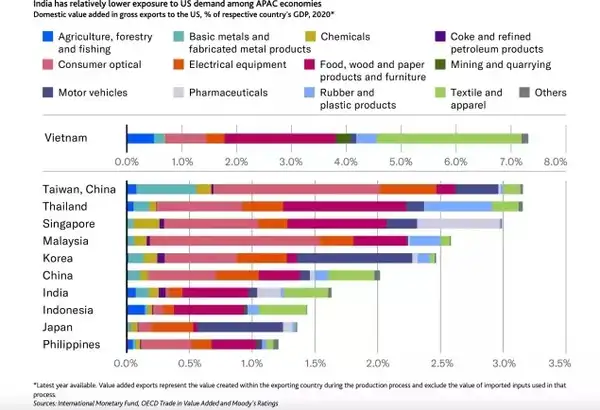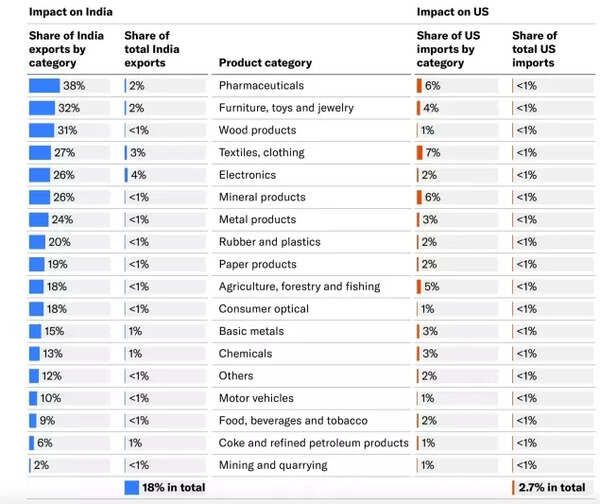Explained: Why India is well positioned to deal with negative effects of Trump’s tariffs & top reasons it will be at an advantage

US President Donald Trump is disrupting the world economy with his reciprocal tariffs – but India is well positioned not only against the adverse impact of these moves, but may actually be able to take long-term advantage from America’s high duties, says Moody’s in its latest report.Moody’s has said that India’s robust domestic market and minimal export dependency position it favourably to withstand adverse impacts from Trump’s tariffs and global trade disruptions.“India is better positioned than many other emerging markets to deal with US tariffs and global trade disruptions, helped by robust internal growth drivers, a sizable domestic economy and a low dependence on goods trade,” it says.The extensive tariff revisions announced by Trump on April 2 mark the most substantial tariff increase since the 1930s. The reciprocal tariff scheme initially imposed an additional 26% duty on Indian exports to America.Also Read | First phase of India-US trade deal likely before July; India wants full exemption from Donald Trump’s 26% tariffs on certain goods: ReportSubsequently, on April 9, the Trump administration instituted a 90-day pause on implementing most tariffs, establishing a uniform 10% rate for nearly all targeted nations.The implementation of 10% universal tariffs, coupled with 30% duties on Chinese exports to America, is anticipated to restrict global economic growth. This could reduce India’s GDP growth to 6.3% from 6.7% in calendar year 2025. Nevertheless, India would still remain the country with highest amongst G-20 nations, notes Moody’s.What works in India’s favour? Moody’s explains1. India’s economic growth remains anchored by domestic consumption, even as US policy changes pose risks. Government expenditure on infrastructure contributes to GDP growth, complemented by reduced personal taxation that encourages spending, notes Moody’s. 2. India’s modest dependence on goods trade and strong services industry provide protection against US tariff impacts. India faces minimal direct impact from trade tensions. Although the United States remains India’s primary export market, the impact on India’s economic growth remains limited, says Moody’s. This is due to temporary relief measures and India’s comparatively lower dependence on goods exports relative to other Asia-Pacific emerging economies.

India has relatively lower exposure to US demand among APAC countries (Moody’s)
3. Indian products could potentially gain from increased US purchases if negotiations result in preferential tariff treatment compared to other developing nations.4. Infrastructure sector growth is accelerating through sustained investment. Consistent requirements across power generation, transport networks and digital systems continue to draw substantial capital commitments over the upcoming 5-7 years. US trade measures are expected to have limited influence on most infrastructure segments due to their primary focus on domestic market requirements.5. Local market focus provides insulation to non-financial enterprises from tariff effects. The expansion of infrastructure alongside positive population dynamics supports Indian non-financial companies’ operations. Notable government capital allocation strengthens various sectors including construction, resource extraction and industrial production.6. India’s banking industry demonstrates resilience against potential market volatility. Indian banks exhibit robust financial health through strong profits and capital reserves.Also Read | Benefit for India: How Indian ports will gain from China+1 strategy – Moody’s explains7. In May 2025, India and the UK finalised a comprehensive free-trade agreement after extensive negotiations. This agreement indicates a shift towards trade openness as a strategic response to US tariff measures, contrasting with India’s traditional protective trade stance. Concurrent negotiations continue with the European Union for a similar FTA, whilst discussions with the US focus on reducing the punitive tariffs implemented in April.8. India’s demographic advantage significantly contributes to its economic growth. The nation’s substantial youthful population exhibits increased spending tendencies, both for personal needs and their offspring, unlike earlier generations. The expanding consumer credit industry further strengthens this consumption pattern.The negatives* Some industries face current or forthcoming sector-specific tariffs. The United States has imposed 25% tax on imported vehicles, automobile components, steel and aluminium, negatively affecting companies in these industries.* The majority of Indian firms rated by Moody’s in these sectors have minimal direct US market exposure or possess adequate safeguards, including robust domestic operations, varied supply networks and US-based facilities, to manage the impact. Nevertheless, they remain susceptible to trade flow disruptions and possible regional supply increases, particularly from China.

Indian goods most exposed to US tariffs based on 2024 trade data (Moody’s)
* Furthermore, the Trump administration is considering tariffs on additional sectors, including pharmaceuticals, which represents one of India’s largest export categories to the US, unless ongoing trade negotiations between both nations produce substantial outcomes.* Although not directly affected by tariffs, business service organisations face risks from US immigration policy changes. More stringent US immigration regulations will reduce the workforce availability and restrict operations of Indian service providers who deploy their staff to the US. Despite service firms gradually increasing local US recruitment, many still depend on skilled H1B visa workers for extended US assignments, making them vulnerable to immigration policy modifications and increased operational costs.Also Read | Why Apple won’t find it easy to move iPhone production from India to USLong-Term Advantage IndiaMoody’s is of the view that high tariffs will drive supply chain relocations nearer to end-consumer markets. India stands to gain from potential investment flows targeting its substantial and expanding market, which could reverse the current downward trend in foreign direct investments.In the longer term, increased US tariffs on other APAC emerging economies like China, Vietnam, Thailand and Cambodia present opportunities for India to increase its US market share in textiles, apparel, footwear and electronics exports.The growth of labour-intensive manufacturing sectors will contribute to job creation.The electronics industry’s ability to capitalise on ongoing supply chain alterations will rely on trade and investment policy adjustments that enable smoother cross-border movement of intermediate products, fostering regional connectivity. To put it simply…How a India-US trade deal will work out is anybody’s guess – discussions are ongoing and analysts hope that a mutually beneficial deal will come through shortly. Reports suggest that a three-phase deal is in works, with the first phase likely to be finalised before July, which is around the time that the 90 day tariff pause deadline ends.Meanwhile, India is set to overtake Japan to become the world’s fourth largest economy this year. In the coming years, it will become the third largest after United States and China. As experts acknowledge globally, the Indian economy’s biggest strength lies in its fundamentally sound domestic growth story. As it looks to increase the share of exports in its GDP, trade deals with countries other than the US will also play a crucial role.Additionally, a relative tariff advantage over major economies like China, may eventually work in India’s favour with the China+1 strategy bearing fruit as the world expands supply chains in India.Also Read | Advantage or disadvantage? How the US-China trade deal will likely impact India – explained




